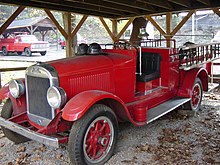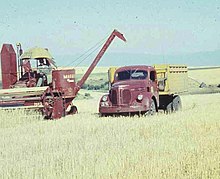
The REO Motor Car Company was a company based in Lansing, Michigan, which produced automobiles and trucks from 1905 to 1975. At one point, the company also manufactured buses on its truck platforms.
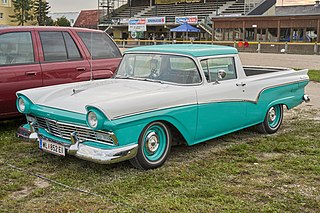
The Ford Ranchero is a coupe utility that was produced by Ford between 1957 and 1979. Unlike a standard pickup truck, the Ranchero was adapted from a two-door station wagon platform that integrated the cab and cargo bed into the body. A total of 508,355 units were produced during the model's production run. Over its lifespan it was variously derived from full-sized, compact, and intermediate automobiles sold by Ford for the North American market.

Ransom Eli Olds was a pioneer of the American automotive industry, after whom the Oldsmobile and REO brands were named. He claimed to have built his first steam car as early as 1887 and his first gasoline-powered car in 1896. The modern assembly line and its basic concept is credited to Olds, who used it to build the first mass-produced automobile, the Oldsmobile Curved Dash, beginning in 1901.

Commer was a British manufacturer of commercial and military vehicles from 1905 until 1979. Commer vehicles included car-derived vans, light vans, medium to heavy commercial trucks, and buses. The company also designed and built some of its own diesel engines for its heavy commercial vehicles.

Crosley was a small, independent American manufacturer of subcompact cars, bordering on microcars. At first called the Crosley Corporation and later Crosley Motors Incorporated, the Cincinnati, Ohio, firm was active from 1939 to 1952, interrupted by World War II production. Their station wagons were the most popular model, but also offered were sedans, pickups, convertibles, a sports car, and even a tiny jeep-like vehicle. For export, the cars were badged Crosmobile.
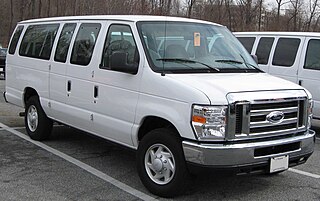
The Ford E-Series is a range of full-size vans manufactured and marketed by the Ford Motor Company. Introduced for 1961 as the replacement of the Ford F-Series panel van, four generations of the model line have been produced. Marketed for both cargo and passenger transport configurations, the E-Series has been designed with multiple design variations for both retail and commercial sale, including vans, and commercial-grade cutaway van chassis and stripped chassis.

The Jeep Gladiator, Jeep Pickup or J-series is a series of full-size pickup trucks based on the large Jeep SJ (Wagoneer) platform, which was built and sold under numerous marques from 1962 until 1988. The Jeep Gladiator/Pickup design is noteworthy for remaining in production for more than 26 years on a single automobile platform generation. The Gladiator was the basis of the first post-war U.S. Army trucks designed to be civilian vehicles and adapted to military use. Numerous versions of the Jeep pickup were built in other markets, including Mexico by Vehículos Automotores Mexicanos (VAM) and Argentina by Industrias Kaiser Argentina (IKA).

A panel van, also known as a blind van, car-derived van or sedan delivery, is a small cargo vehicle with a passenger car chassis, typically with a single front bench seat and no side windows behind the B-pillar. Panel vans are smaller than panel trucks or cargo vans, both of which use body-on-frame truck chassis.
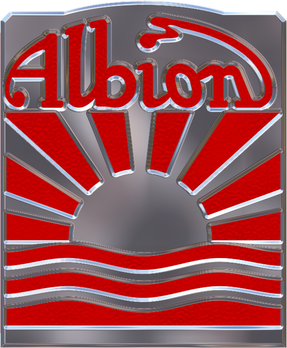
Albion Motors was a Scottish automobile and commercial vehicle manufacturer.

The Vulcan Motor and Engineering Company Limited, of Southport, England, made cars from 1902 until 1928 and commercial vehicles from 1914 until 1953.
The name Chevrolet Greenbrier was used by Chevrolet for two vehicles. The first vehicles were a six-to-nine-passenger window van version of the Corvair 95 van. The Corvair 95 series also included the Loadside pickup truck and Rampside pickup truck that featured a mid-body ramp on the right side. All used the Corvair powertrain in a truck body and were produced in the model years 1961 to 1965.

The Mitsubishi Delica is a range of vans and pickup trucks designed and built by the Japanese automaker Mitsubishi Motors since 1968. It was originally based on a cabover van and pickup truck introduced the previous year, also called the Delica, its name a contraction of the English language phrase Delivery car. This pickup truck, and a commercial van derived from it has received many names in export markets, being sold as the L300 in Europe, Jamaica and New Zealand, Express and Starwagon in Australia, and plain Mitsubishi Van and Wagon in the United States. The passenger car versions were known as Delica Star Wagon from 1979 until the 1994 introduction of the Delica Space Gear, which became simply Space Gear in Europe at least. The most recent version is called the Delica D:5. With the exception of the first, versions of all generations are still being sold in various international markets.

The Diamond T Company was an American automobile and truck manufacturer. They produced commercial and military trucks.

The Suzuki Carry is a kei truck produced by the Japanese automaker Suzuki. The microvan version was originally called the Carry van until 1982 when the passenger van versions were renamed as the Suzuki Every. In Japan, the Carry and Every are kei cars but the Suzuki Every Plus, the bigger version of Every, had a longer bonnet for safety purposes and a larger 1.3-liter 86-hp (63 kW) four-cylinder engine. They have been sold under myriad different names in several countries, including those with Chevrolet and Ford badges.

The Speedwell Motor Car Company was a Brass Era American automobile manufacturing company established by Pierce Davies Schenck that produced cars from 1907 to 1914. The Great Dayton Flood of 1913 greatly damaged the Speedwell factory and inventory, and the company entered receivership in 1915 after having built an estimated 4,000 cars and trucks.

The Isuzu Faster is a pickup truck that was manufactured and marketed by Isuzu between 1972 and 2002 over three generations. The Faster was succeeded worldwide by Isuzu D-Max, except in Japan and North America.

Straker-Squire was a British automobile manufacturer based in Bristol, and later Edmonton in North London.
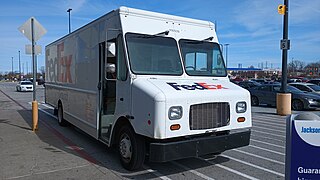
A multi-stop truck is a type of commercial vehicle designed to make multiple deliveries or stops, with easy access to the transported cargo held in the rear. They are usually vans or trucks designed to be used as fleet vehicles by businesses within local areas. They typically use commercial truck chassis with a generally larger, taller body and sometimes also a longer or shorter wheelbase. Though they have traditionally been powered by internal combustion engines, into the 21st century many multi-stop trucks have begun shifting to electric truck platforms.

Shinjin Motors or Sinjin Motors is a defunct South Korean car manufacturer.
The International Harvester Auto-Buggy is a two-cylinder, air-cooled motor car made by International Harvester Corporation. First announced in February 1907, the Auto-Buggy was dropped from their range of products in early 1912, but the Auto Wagon continued to 1917.


